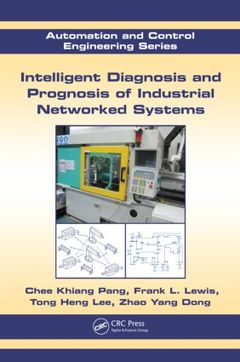Description
Intelligent Diagnosis and Prognosis of Industrial Networked Systems
Automation and Control Engineering Series
Automation and Control Engineering Series
Authors: Pang Chee Khiang, Lewis Frank L., Lee Tong Heng, Dong Zhao Yang
Language: English
Subjects for Intelligent Diagnosis and Prognosis of Industrial...:
Keywords
Small Signal Stability; diagnosis and prognosis; DEC; condition-based monitoring; Small Signal Stability Analysis; structural health monitoring; DFI; fault detection and isolation; Eigenvalue Sensitivity; large-scale systems; Tool Wear; singular value decomposition; Industrial Networked Systems; eigenvalues; Inter-area Mode; sensitivity analysis; IM Load; AE Signal; discrete event systems; England Test System; Composite Load; Critical Eigenvalues; Identified Transfer Function; Armax Model; Mechatronic Systems; Resonant Poles; Measured Tool Wear; Generalized Eigenvectors; Green House Gases; Experimental Frequency Response; AE Sensor; IEEE Type; System State Matrix
46.39 €
In Print (Delivery period: 15 days).
Add to cartPublication date: 07-2011
Support: Print on demand
17.67 €
In Print (Delivery period: 14 days).
Add to cartPublication date: 04-2017
· 15.6x23.4 cm · Paperback
Description
/li>Contents
/li>Readership
/li>Biography
/li>
In an era of intense competition where plant operating efficiencies must be maximized, downtime due to machinery failure has become more costly. To cut operating costs and increase revenues, industries have an urgent need to predict fault progression and remaining lifespan of industrial machines, processes, and systems. An engineer who mounts an acoustic sensor onto a spindle motor wants to know when the ball bearings will wear out without having to halt the ongoing milling processes. A scientist working on sensor networks wants to know which sensors are redundant and can be pruned off to save operational and computational overheads. These scenarios illustrate a need for new and unified perspectives in system analysis and design for engineering applications.
Intelligent Diagnosis and Prognosis of Industrial Networked Systems proposes linear mathematical tool sets that can be applied to realistic engineering systems. The book offers an overview of the fundamentals of vectors, matrices, and linear systems theory required for intelligent diagnosis and prognosis of industrial networked systems. Building on this theory, it then develops automated mathematical machineries and formal decision software tools for real-world applications.
The book includes portable tool sets for many industrial applications, including:
- Forecasting machine tool wear in industrial cutting machines
- Reduction of sensors and features for industrial fault detection and isolation (FDI)
- Identification of critical resonant modes in mechatronic systems for system design of R&D
- Probabilistic small-signal stability in large-scale interconnected power systems
- Discrete event command and control for military applications
The book also proposes future directions for intelligent diagnosis and prognosis in energy-efficient manufacturing, life cycle assessment, and systems of systems architecture. Written in a concise and accessible style, it presents tools that are mathematically rigorous but not involved. Bridging academia, research, and industry, this reference supplies the know-how for engineers and managers making decisions about equipment maintenance, as well as researchers and students in the field.
Introduction. Vectors, Matrices, and Linear Systems. Modal Parametric Identification (MPI). Dominant Feature Identification (DFI). Probabilistic Small Signal Stability Assessment. Discrete Event Command and Control. Future Challenges. References. Index.
Chee Khiang Pang is an Assistant Professor in the Department of Electrical and Computer Engineering at National University of Singapore.
Frank L. Lewis is a Professional Engineer and Head of Advanced Controls and Sensors Group at the Automation and Robotics Research Institute, The University of Texas at Arlington.
Tong Heng Lee is Professor and cluster Head for the Department of Electrical and Computer Engineering at National University of Singapore.
Zhao Yang Dong is Associate Professor for the Department of Electrical Engineering at The Hong Kong Polytechnic University.



